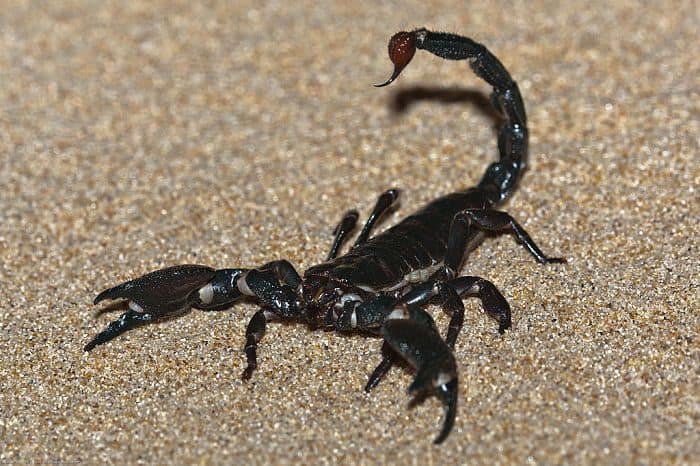Table of Contents
Overview
- Life Expectancy: 5-8 years
- Size (Adult): 6-12 inches
- Natural Habitat: Western Africa
- Scientific Name: Pandinus imperator
- Other Names: Imperial scorpion

Housing
A glass terrarium is recommended for emperor scorpions as this ensures temperature can be regulated efficiently. It is important that the terrarium is large enough to offer sufficient room for your scorpion to move about freely. A 10-gallon tank is suitable for one scorpion but for groups of scorpions, a 20-30-gallon tank is recommended.
Scorpions enjoy having places to hide and will also require substrate that is at least two inches deep (preferably deeper) so that they can dig or burrow.
Common types of substrate include:
- coconut husk
- sterilized potting soil
- peat
- cocoa fiber
- cork bark
- sphagnum moss.
For hides you could use broken ceramic flowerpots, pieces of bark, rocks, or special reptile hides that can be purchased online (see here for a great selection at Amazon – opens in a new tab) or from your local pet store. You might also want to add some artificial plants that also act as good hiding places.
Heating and Lighting
Hailing from Western Africa, emperor scorpions are naturally used to high temperatures. This means that you will need to use an artificial heating method to achieve these temperatures. UVB lights are not necessary as scorpions are nocturnal creatures, but it is important to have a temperature gradient within the terrarium. The cooler end should be between 70F and 75F while the warmer end should offer temperatures between 90F and 100F.
You can use a heat mat or heat lamps, but make sure that if you are using a heat mat it covers no more than one third of the terrarium base. It is essential to monitor the temperature of your scorpion’s terrarium because if it gets too hot, it is likely that the creature will burrow deep into the substrate to try to cool down, but this will then only move it closer to the heat mat. A good terrarium thermometer is recommended. Click here to check out heating solutions and here for a range of terrarium thermometers. Both links point to Amazon and open in a new tab.
In addition to a temperature gradient, you must also be cognizant of humidity levels. A scorpion’s terrarium should ideally have humidity levels of around 75%. The substrate should be moist but not wet, which can be achieved by daily misting.
Feeding
In the wild, emperor scorpions eat a variety of insects as well as small lizards. They might even eat any smaller scorpions they happen to encounter. In captivity, your scorpions can be fed feeder insects such as crickets. It is crucial that you feed gut-loaded crickets that have been dusted with calcium to your scorpions. You can supplement their diet with moths or mealworms as occasional treats.
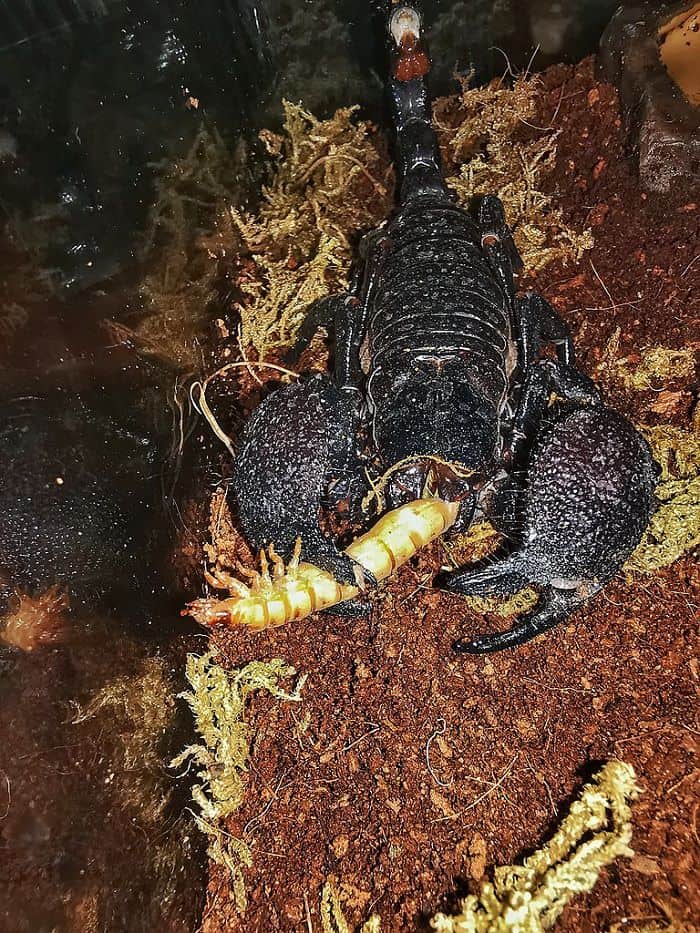
Scorpions are strict carnivores meaning they will not eat any plant-based foods, so don’t try to feed your scorpion with fruit or vegetables. It is also not recommended to give your scorpion bugs that you find in your house as you do not know what these bugs have been eating. It is important to provide only gut-loaded insects that have been purchased from a reputable supplier.
meaning they will not eat any plant-based foods, so don’t try to feed your scorpion with fruit or vegetables. It is also not recommended to give your scorpion bugs that you find in your house as you do not know what these bugs have been eating. It is important to provide only gut-loaded insects that have been purchased from a reputable supplier.
Juvenile scorpions should be fed every day while adult emperor scorpions only require feeding every other day. Adult scorpions will typically eat between three and six crickets per week. It is recommended that you begin with two to three crickets and place them in the tank on the substrate near to your scorpion. Do not place more than this in one go and only add more once the scorpion has consumed the first couple. Do remember that scorpions are nocturnal creatures so should be fed at night. Remove any uneaten crickets the following morning to prevent them from attacking your scorpion while it is resting.
Water is also necessary in the terrarium. It should be provided in a small shallow dish and changed daily.
Handling
Although emperor scorpions are considered quite docile, they should not be handled as they can pinch or sting when feeling threatened. If you do need to move your scorpion (for example, to clean the terrarium), it is recommended that you coax it into a plastic tub by using the lid to gently push it towards the container. Make sure that any tub or box you place the scorpion in has a lid with holes in for ventilation. Some people prefer to use a forceps or tongs to pick up their scorpion, but this can cause damage to the shell if not done with proper care and diligence.
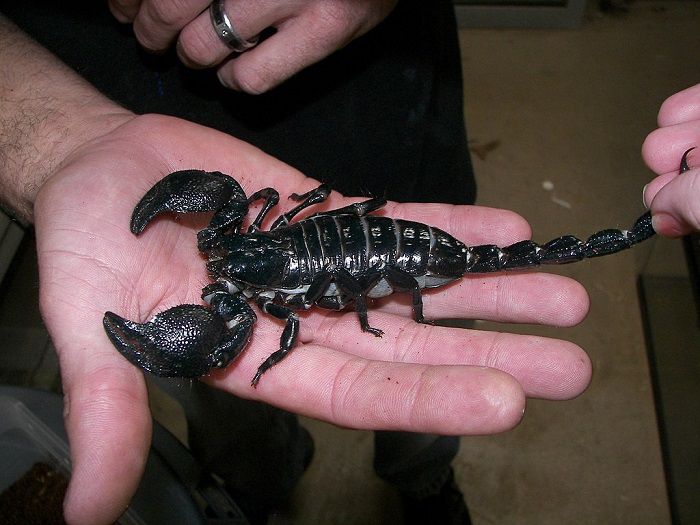
Health
In the right environment, emperor scorpions will thrive. However, they are prone to dehydration, so the above-mentioned correct humidity levels really are an essential consideration. If you notice that your scorpion is lethargic and looks kind of shriveled, it might just be that it is dehydrated. Increasing the humidity in the enclosure should see it perk up. Nevertheless, it is always best to consult your nearest exotic vet if you are worried.
Also note that scorpions will molt a number of times before reaching adulthood. They shed their old shell as they grow, so you can expect this to happen around six times in the first three years. Just before a molt, scorpions often retreat into a hide and may become inactive as they try to conserve energy. They might also refuse food for a while.
One sign that a molt is imminent is cracks on a scorpion’s shell. If you notice cracks, then it is a good idea to remove any uneaten live food from the enclosure as your scorpion may be much more vulnerable to attacks and bites from insects during molting. Also make sure humidity levels are higher during molting periods as higher humidity helps with shedding process.
When not undergoing a molt, a healthy scorpion will be active and alert and will have a healthy-looking exoskeleton. It will be eating regularly and have a body and tail that is full and rounded. If you notice that your scorpion is not eating and appears to be losing weight, this could be an indication of illness. This is especially so if coupled with other symptoms such as:
- lethargy
- swollen limbs
- abnormal feces
- dull exoskeleton.
If you notice any of these symptoms, contact your vet for advice.
Do Scorpions Live Alone or in a Group?
In the wild, emperor scorpions are solitary creatures. They are not social and prefer not to live in groups. It is therefore not recommended to keep more than one in the same tank as they might fight over food and space. Emperor scorpions can become territorial so if you do decide to house more than one it is imperative that you have enough space and hides for them to avoid each other.
Breeding
Upon reaching the age of about three, emperor scorpions are sexually mature and ready to mate. In the wild, male and female emperor scorpions will come together and he will grasp her and push her around until he finds a suitable place. He will then deposit his sperm before pulling her over it. She will accept the sperm into her genital opening. Once this occurs, the male will quickly retreat to avoid being eaten.
If you are hoping to breed emperor scorpions in captivity, you will obviously need to ensure you have both a male and female. The best way to sex emperor scorpions is to place them in a clear container and look at them from underneath. You can look at their genital openings and compare them to photos online of male and female genitalia. Females are generally longer and rounder than males, but you will need to check the genital openings too to be sure.
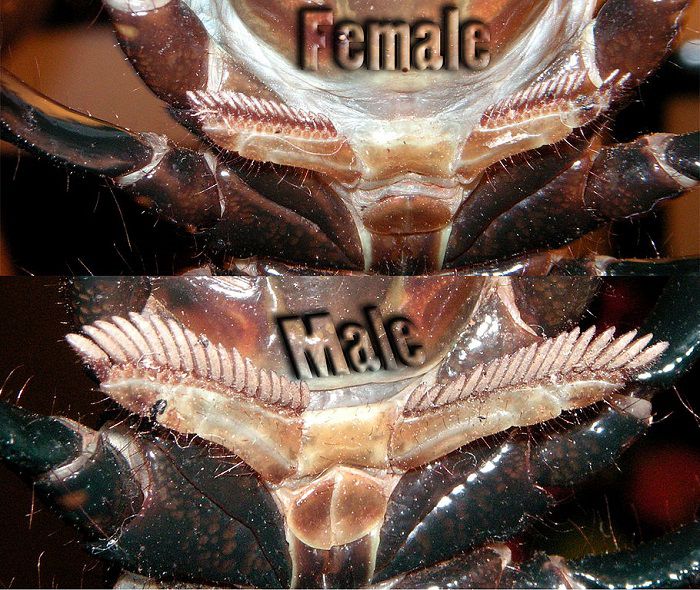
Ensure the temperature in the terrarium is warm for mating to occur. Make sure that your terrarium is large enough for both scorpions before placing them together as they like to move about quite a bit when mating. Once the mating has occurred, remove the male from the tank.
Gestation for emperor scorpions is typically between seven and ten months after which it is possible for the female to give birth to as many as 30-35 scorplings. The young will stay on their female’s back until their first molt. Once they have left their mother’s back, they will then be ready to accept small crickets and other small insects.
It is important that you do not disturb the female and her young if possible as it is not uncommon for her to eat scorplings that fall from her back.
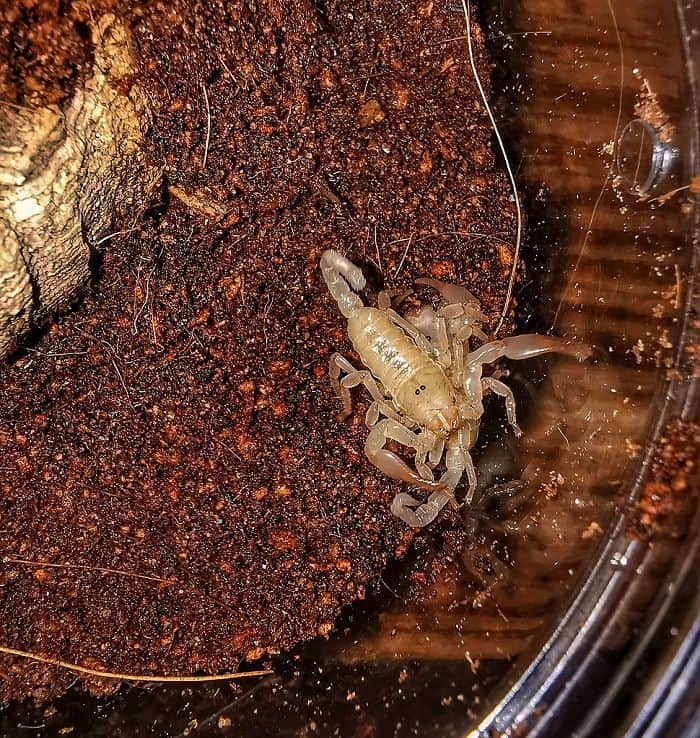
Photo Credits:
- Featured Image (Emperor Scorpion): Mike Baird – CC BY 2.0

- Emperor Scorpion Feeding: DigitalLem0n – CC BY-SA 4.0

- Specialists Handling an Emperor Scorpion: John
 – CC BY 2.0
– CC BY 2.0
- Emperor Scorpion Sexing Pectens: Psychonaught – public domain
- Baby Emperor Scorpions – Scorplings: DigitalLem0n – CC BY-SA 4.0


